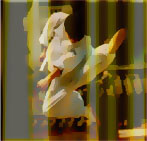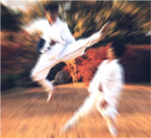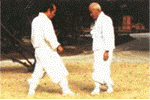Taekkyon
..................................![]() Overview
Overview
![]() PKG Tours
PKG Tours
![]() Video Clips
Video Clips
..................................
![]()
Jeju Championship

¢Ñ Tour Courses | ¢Ñ Training | ¢Ñ Demonstration
![]() 6N7D
6N7D
-D1 : Arrival
and Transfer to Hotel
-D2 :
Full day city tour including
Palace, Museum, Open market, Taekkyon supply shopping
-D3 : Visit
Chungju Taekkyon HQ and
orientation with demonstration
-D4 : Morning
training and half day Mt. Wolak Nat'l Park Mungyongsaejae hiking
-D5 :
Morning training and enroute
to Seoul
-D6 :
Full day free at leisure and
farewell party
-D7 :
Free at leisure and transfer
to airport
![]() 13N14D
13N14D
-D1 : Arrival
and Transfer to Hotel
-D2 :
Full day city tour including
Palace, Museum, Open market, Taekkyon supply shopping
-D3
: Visit
Chungju Taekkyon HQ and
orientation with demonstration
-D4 :
Morning training and half day
city or suburban culture tours
-D5 :
Morning training and half
day city or suburban culture tours
-D6 : Morning training
and half day city or suburban culture tours
-D7 : Morning training
and half day city or suburban culture tours
-D8 : Morning training
and half day city or suburban culture tours
-D9 : Morning training
and half day city or suburban culture tours
-D10
: Sparring
and competition
-D11 :
Final training and evaluation
-D12
: Tour
to the Liberation memorial hall, Yongin folk village or Everland themepark and enroute
to
Seoul
-D13 :
Full day free at leisure
-D14
: Free
at leisure and transfer to airport
PKG TOURS




¢º Techniques and Movements
Taekkyon is an art form
that looks like a dance, but has much more power and agility. Its
name was
derived from the word for "kick". The Kyollyon
was a folk competition held in local villages, where the
people
were able to join and match skills. Kyollyon was developed during
the Joseon Dynasty, by
Song Deok-Gi. Taekkyon has techniques
that can kill an opponent in a single move and Song Deok-Gi
made it policy not to use those techniques.
Pum-bap-gi :
This is the basic stepping motion, where the feet are moved in a
triangle motion (from
the Chinese
character "Pum"). This follows rythym and pattern, but
changes by
situation.
The actual movement is done by taking one step forward, shifting
weight on
to
the other leg and continue, back and forth. This can be done on
the right or the
left
side, and has many variations.
Hwal-gye-jit : This means, waving both arms. There are two intentions
for this. The first is to prepare
for
the attack and the second to enhance the energy of the upper body.
There are
also
many variations. Othundulgi, cross wave. Gawijil,
scissor like motion. Matdulgi,
simultaneous
wave. Dupal-Heundulgi, shaking both arms. Dolligi,
spinning. These
are
but a few of the aspects of Hwal-gye-jit.
¢º Basic Leg and Feet Motion
I-dan-chuk
: Means
kicking opponent's neck in
pushing manner. When done consecutively, called
Bibigi.
This kick is done with the center of the foot.
Dot-geol-i
: Using palm to attack the
shoulder in a pushing manner. Then, lifting right leg, hook and
pull
at opponents joint (ankle or knee). This is done while in Pum-bap-ki
position on the
left
side.
Nak-si-geol-i : Slide leg between the opponents, tug abruptly at joint using your heel.
Kkak-um-da-ri : Lift leg with foot joint raised. Use leg to smoothly wipe opponent.
Pal-deung-geol-i : Curve toes inward, block opponent's foot with yours.
An-jjang-geol-i : Hook opponent's heel with top of your foot, pull it towards you, advacing forward.
An-ul-gol-i
: Strike opponent's inner
foot-joint with sole of your foot, pushing him.
This
drops him to the ground.
¢º Kicks
Jae-kyo-cha-gi : Bending knee completely, lift top of foot into a kick at face level.
Hu-ryo-cha-gi
: Bending knee completely,
lift and kick diagonally. Kick outward to inward along your
shoulder
level and smack!
Jae-cha-gi
(or Gyok-cha-gi) : Bend knee,
turn waist. KIck at opponent side. Kick using top of foot,
inward
to outward. Can also aim for the thighs.
¢º Hand Techniques
Kal-jaep-i
: Means
'Man holding the yoke' (from
the word Kaljabi). Widen thumb and fingers,
strike
neck.
Kal-lo-mil-gi
: Hand faces sideways, stick
neck. Follow through by pushing, putting your weight into
it.
Attention and caution. This technique can inflict severe damage.

¢º Pum-Bap-Gi : Bit-bap-gi, Gil-gye-bap-gi, Nul-reo-bap-gi, Je-pum-bap-gi
 ¢º Eol-Reo-Mae-Gi-Gi :
¢º Eol-Reo-Mae-Gi-Gi :
An-jjagn-geol-i ¡æ Hoe-mok-chi-gi, Deol-mi-Jaep-i
An-jjagn-geol-i ¡æ Deot-geol-i, Deol-mi-geol-i
An-jjagn-geol-i ¡æ Dwi-hoe-mok-chi-gi, Bit-jang-ji-ru-gi
Bat-jang-chi-gi
¡æ Maem-dol-ri-gi ¡æ O-gum-bap-gi
Bat-jang-chi-gi ¡æ Bat-nak-geol-i, Deol-mi-geol-i
Bat-jang-chi-gi
¡æ Eo-bok-chi-gi, Bit-jang-ji-ru-gi
Hoe-mok-chi-gi
¡æ An-nak-geol-i, Deol-mi-geol-i
Hoe-mok-chi-gi
¡æ Kal-jaep-i, An-nak-geol-i
Hoe-mok-chi-gi
¡æ Dwi-hoe-mok-chi-gi, Deol-mi-jaep-i
¢º Mat-Dae-Geol-I
¢º Ta-Bop
![]() For further information
or to make a reservation, please contact us :
For further information
or to make a reservation, please contact us :
happy@iculturetour.com / Tel : 82-2-878-3977 / Fax : 82-2-871-3464





